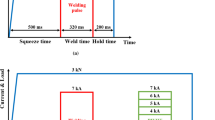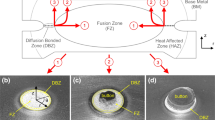Abstract
This work gives an insight in the transient softening at the fusion boundary of resistance spot welds of hot stamped steel 22MnB5. The development of the softened region was investigated for three different energy input concepts with short, middle, and long welding times; thereby, an experimental technique of interrupted spot welds combined with metallographic investigations and hardness measurements was employed. The observed softening can be explained with the effect of carbon segregation, supported by the diffusional γ → δ phase transformation or delta-ferrite nucleation from the liquid L → δ, which may lead to formation of δ-Fe at the fusion boundary. Subsequent quenching at cooling speeds of about 2500 °C/s after the welding process prevents carbon redistribution and decomposition of δ-Fe. This assumption is in good agreement with the results of carbon measurement at the fusion boundary and metallographic observations. The influence of the softened region on fracture of resistance spot welds was investigated, using cross-tension test and metallographic analysis. The transition of the fracture mode from fracture through the weld nugget for short welding time to fracture along the fusion boundary for long and middle welding times is observed. Marginally higher maximal force and energy absorption by welded joints with long welding times was observed.















Similar content being viewed by others
References
Specification for automotive weld quality—resistance spot welding of steel D8.1M: 2007. Miami, FL
Saha DC, Ji CW, Park YD (2015) Coating behaviour and nugget formation during resistance welding of hot forming steels. Sci Technol Weld Join 20(8):708–720
Rosner M. Kleben von verzinktem presshärtenden Stahl. In: DVS Media GmbH (Hrsg.): DVS Congress 2015. Grosse Schweisstechnische Tagung: DVS-Studentenkongress: Fügen von faserverstärkten Kunststoffen, anwendungsnahe Schweisssimulation, Schulung und Prüfung im DVS: IBESS - Forschungscluster "Bruchmechanik" : Vorträge der gleichnamigen Tagung im Rahmen von DVS Congress und DVS Expo in Nürnberg vom 15. bis 17. September 2015. Düsseldorf 2015
Cho YJ, Chang IS, Lee HB (2008) Advanced resistance spot welding technologies. New machine, adaptive control and fem simulation. Mater Sci Forum 580–582:367–370
Baryliszyn P (2015) Widerstandspunktschweißen für große Bauteiltoleranzen: TUDpress. Dresden
Schuster, L.; Sommer, S.: Characterization and modelling of soft zones around spot welds in high strength steels: proceedings of the 5th international conference on steels in cars and trucks steels in cars and trucks 2017 2017
Jong Y-S, Lee Y-K, Kim D-C, Kang M-J, Hwang I-S, Lee W-B (2011) Microstructural evolution and mechanical properties of resistance spot welded ultra high strength steel containing boron. Mater Trans 52(6):1330–1333
Eller TK (2016) Modeling of tailor hardened boron steel for crash simulation: University of Twente. Enschede
Li YB, Li DL, David SA, Lim YC, Feng Z (2016) Microstructures of magnetically assisted dual-phase steel resistance spot welds. Sci Technol Weld Join 21(7):555–563
Sherepenko O, Jüttner S. Schweißtechnische Verarbeitung höchstfester Stähle. Widerstandspunktschweißen unter Berücksichtigung fertigungs-bedingter Spalte: 34. Assistentenseminar Füge- und Schweißtechnik. Vorträge der gleichnamigen Veranstaltung in Lichtenwalde vom 26. bis 28. September 2013. Düsseldorf 2014
Karbasian H, Tekkaya AE (2010) A review on hot stamping. J Mater Process Technol 210(15):2103–2118
Wink H-J, Krätschmer M (2012) Charakterisierung und Modellierung des Bruchverhaltens von Punktschweißverbindungen in pressgehärteten Stählen. Teil II - Simulation des Schweißens. Ulm
Harlin N, Jones TB, Parker JD (2002) Weld growth mechanisms during resistance spot welding of two and three thickness lap joints. Sci Technol Weld Join 7(1):35–41
Geslain E, Rogeon P, Pierre T, Pouvreau C, Cretteur L (2018) Coating effects on contact conditions in resistance spot weldability. J Mater Process Technol 253:160–167
Brandes EA, Brook GB, Smithells CJ (1998) Smithells metals reference book, 7th ed / edited by E.A. Brandes and G.B. Brook: Butterworth-Heinemann. Oxford, Boston
Funding
The authors would like to acknowledge the province Saxony-Anhalt for financial support of the study in the framework of the postgraduates funding and thank all the students and colleagues, who have contributed their effort to the investigations.
Author information
Authors and Affiliations
Corresponding author
Additional information
Recommended for publication by Commission III - Resistance Welding, Solid State Welding, and Allied Joining Process
Rights and permissions
About this article
Cite this article
Sherepenko, O., Jüttner, S. Transient softening at the fusion boundary in resistance spot welded ultra-high strengths steel 22MnB5 and its impact on fracture processes. Weld World 63, 151–159 (2019). https://doi.org/10.1007/s40194-018-0633-3
Received:
Accepted:
Published:
Issue Date:
DOI: https://doi.org/10.1007/s40194-018-0633-3




